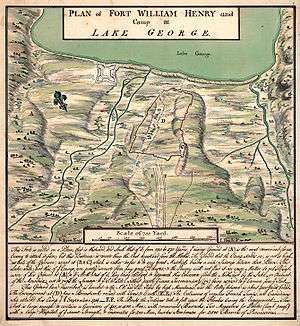William Eyre (lieutenant-colonel)
| William Eyre | |
|---|---|
| Born | unknown |
| Died | 1764 |
| Allegiance |
|
| Service/branch |
|
| Rank | Lieutenant-Colonel |
| Unit |
Royal Engineers 44th Foot |
| Battles/wars |
Battle of Lake George Battle of Carillon |
| Awards | Voted the thanks of the General Court of Rhode Island 1756 [1] |
| Relations | Mary Henzell, wife[2] |
William Eyre (died 1764) was an officer in the British Army during the French and Indian Wars.
Early life

Eyre served in the Royal Engineers during the Jacobite rising of 1745 and the War of the Austrian Succession.[3]
North America
Eyre came to North America in 1755 as a captain in 44th Foot. He planned Fort Edward under orders from general Phineas Lyman. During the Battle of Lake George he commanded the artillery, that defeated repeated French attacks. After the battle he planned and led the construction of Fort William Henry, becoming its first commandant. In 1757 he left the command to George Monro when the 35th Foot relieved the 44th.[3] During the Battle of Carillon he was wounded leading his 888-men strong regiment during the failed attacks to take the French fort.[4] [5] He was later in charge of the rebuilding of Fort Ticonderoga.[6] Having been promoted to Major in the 44th in 1756,[7] he became an Engineer in Ordinary in 1758[4] and Lieutenant-Colonel in his regiment in 1759.[8]
Death
Eyre drowned off the English coast in November 1764 on his way home.[2]
References
- ↑ Samuel Green Arnold (1894), History of the State of Rhode Island and Providence Plantations, Preston & Rounds, vol. 2., p. 198.
- 1 2 John Burke (1838), A genealogical and heraldic history of the commoners of Great Britain and Ireland, London, vol. 4, p. 340.
- 1 2 I.K. Steele (1974), "Eyre, William", Dictionary of Canadian Biography, University of Toronto Press, vol. 3, pp. 214–215.
- 1 2 John Romeyn Brodhead (1858), Documents Relative to the Colonial History of the State of New-York, vol. 10, p. 729.
- ↑ William R. Nester (2008), The Epic Battles for Ticonderoga, 1758 State University of New York Press, p. 120.
- ↑ Alfred Procter James & Charles Morse Stotz (2005), Drums in the Forest, University of Pittsburgh Press, p. 87.
- ↑ Army List (1756), London, p. 65.
- ↑ The Scots Magazine (20) 1758, p. 613.